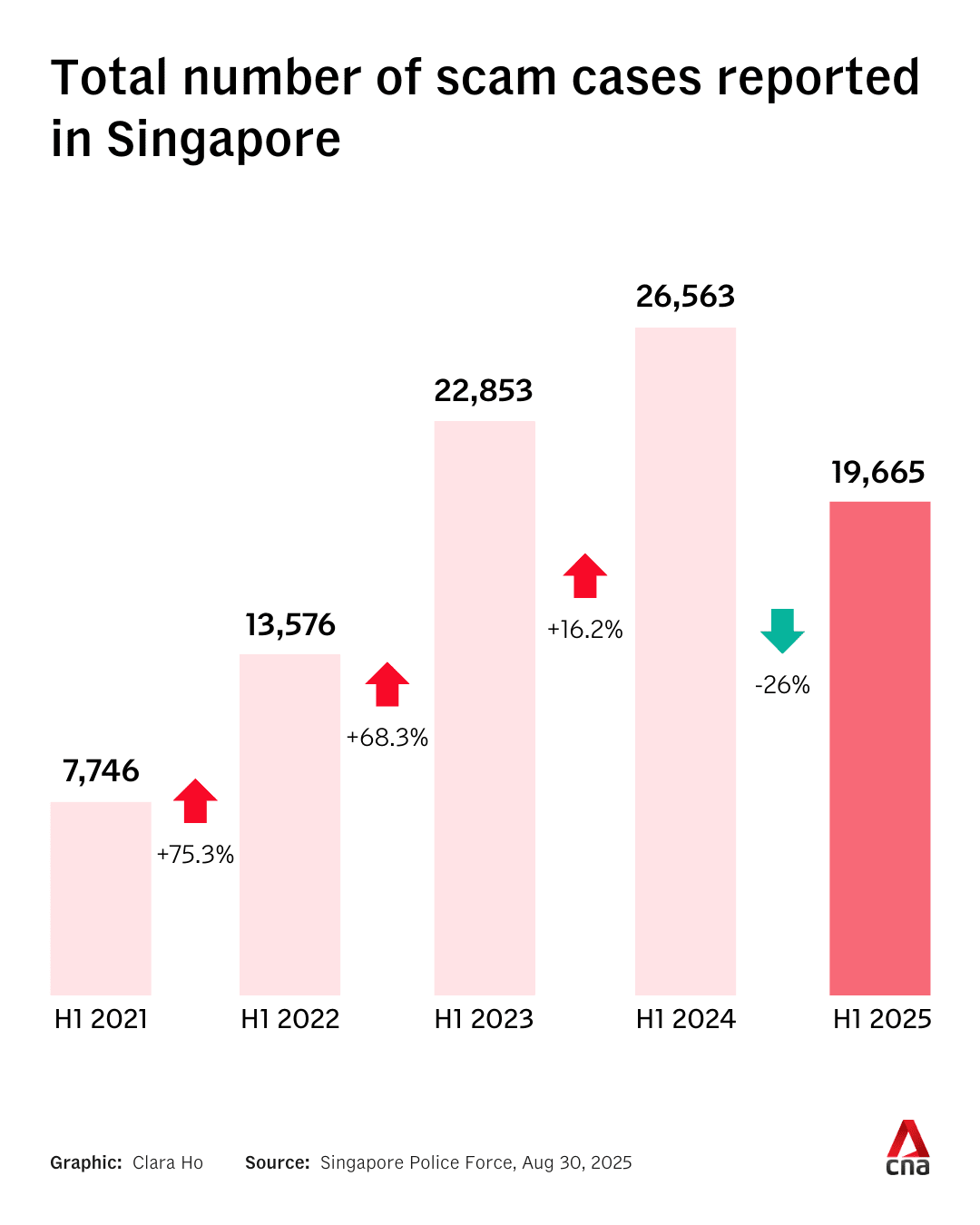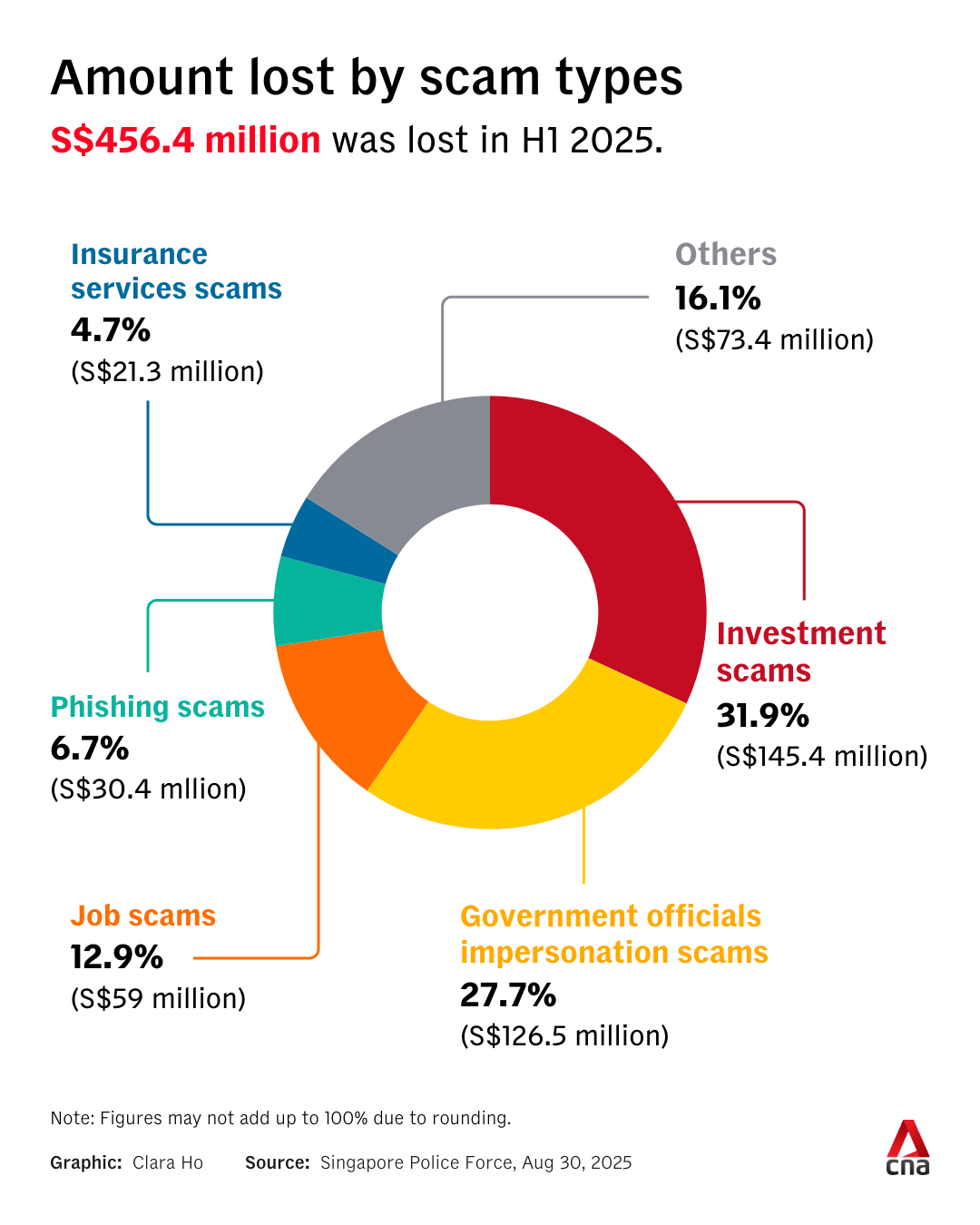Overall scam cases and losses fall, police flag new con involving insurance services
According to police figures for the first half of 2025, the top five scams include phishing scams, e-commerce scams and government officials impersonation scams.

A file photo of a scam alert on a phone. (Photo: iStock)

This audio is generated by an AI tool.
SINGAPORE: The number of scam cases reported in Singapore has fallen after several years of increases.
According to the mid-year figures released by the police on Saturday (Aug 30), there were 19,665 cases in the first half of 2025 - a 26 per cent drop from the 26,563 cases in the same period last year.
The amount lost to scams also decreased by 12.6 per cent in the first half of the year, falling to S$456.4 million (US$354.3 million) from about S$522.4 million in the same period a year earlier.
Losses in cryptocurrency accounted for 17.9 per cent of total scam losses, or about S$81.6 million.
“Scammers target cryptocurrency likely due to its irreversible transactions and limited traceability, making asset recovery virtually impossible, unlike traditional banking transactions,” SPF said in a media release.
The Singapore Police Force (SPF) first started tracking scam-related figures in 2016.
Despite the fall in the overall numbers in the first half of 2025, the police said the situation remains a concern, noting an increase in scams involving the impersonation of government officials, phishing scams and malware scams.

TOP SCAM TYPES
The top five scam types in the first half of this year, in terms of case numbers, were phishing scams, e-commerce scams, job scams, investment scams and government officials’ impersonation scams. They made up more than 70 per cent of total scam cases.
Phishing scams:
This topped the list, making up 19.2 per cent of total scam cases.
A total of 3,779 cases were reported in the first half of the year, a 10.9 per cent increase compared with the same period a year ago.
The amount lost to phishing scams also surged 134 per cent to S$30.4 million from about S$13 million during that same period.
The majority of phishing scam victims were aged 30 to 49. They typically fall for purported deals on social media platforms and are lured into submitting credit card details to scammers for purchases.
Government officials impersonation scams:
Government officials impersonation scam cases almost tripled, from 589 cases in the first half of 2024 to 1,762 cases in the latest tally.
The amount lost to such scams rose by 88.3 per cent to S$126.5 million, the second-highest loss among all scam types.
The police highlighted a rising trend of victims pressured into withdrawing cash, purchasing gold bars or declaring valuable possessions before meeting mules in person to hand over these valuables, purportedly for investigation purposes.
Investment scams:
While the number of investment scams fell by 19.2 per cent in cases in the first six months of this year from the same period a year ago, the amount lost in such cases was the highest among all scam types.
Victims lost about S$145.4 million in the first half of the year, a 10.6 per cent increase compared with the same period a year ago.
Scammers have directed victims to create new cryptocurrency wallets for their purported investment before asking for fund transfers or login credentials. Some victims would receive small profits initially to entice them to invest more money.

Insurance services scams:
The police also flagged a new scam type that emerged this year – the insurance services scam.
A total of 791 cases were reported in the first half of the year, with about S$21.3 million lost.
Scammers would impersonate employees of insurance companies and claim that victims had to pay for their supposed insurance packages or expiring trial subscriptions, unless they are cancelled, the police said. Victims were then asked to verify their identity by sharing personal details and transferring money to proceed with the cancellation.
E-commerce scams:
According to the police's mid-year statistics, there were significant decreases in the number of cases and amount lost for job scams, fake friend call scams and e-commerce scams.
Despite this, e-commerce scams still recorded the second-highest number of reported cases across all scam types in the first half of the year.
Concert tickets were the top item involved in such scams, with related cases accounting for 14.4 per cent of total e-commerce scam cases.
MALWARE SCAMS
Malware-enabled scams jumped by 266.7 per cent, with 363 reported cases in the first half of the year, up from 99 cases in the same period last year.
The majority of malware-enabled scam victims were aged 50 to 64.
Scammers typically abuse the Android Debug Bridge (ADB) function to gain unauthorised remote access to victims’ mobile devices. The ADB is designed as a developer tool to facilitate debugging of Android applications by connecting computers to the devices.
"Members of the public are strongly advised not to turn on the ADB function on their Android devices," the police said.
Despite the surge in cases, the amount lost to such scams fell by 95.6 per cent to S$5.5 million from about S$125.4 million.

ANTI-SCAM INITIATIVES
The fall in scam cases comes as authorities stepped up measures to tackle the issue in recent years.
In January, parliament passed a new law providing the police with powers to order banks to restrict the banking transactions of potential scam victims.
The police said on Saturday that as of Aug 20, two restriction orders were issued under the law, requiring banks to restrict the transactions of two individuals.
Investigations are still ongoing, the police added.
The restriction orders will suspend money transfers, the use of ATM facilities and all credit facilities, although individuals will still be provided access to their funds for daily living expenses.
Other anti-scam efforts include police collaboration with major stakeholders such as Meta, Carousell, Google and telecommunications companies to disrupt online criminal content and activities.
SPF said that in the first half of this year, for instance, it disrupted more than 58,700 mobile lines and 33,300 WhatsApp lines. The figures were an increase of 245 per cent and 122 per cent, respectively, from the same period a year ago.















